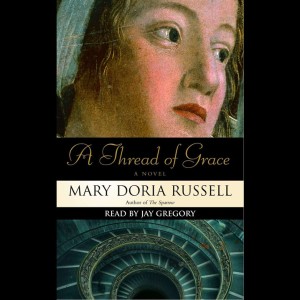
Cover of book A Thread of Grace
The time is September 1943; the place is St. Martin Vésubie. My mother is a single 22-year-old. Along with hundreds of other Jewish refugees, she is living in “residence forcée” under Italian administration. She shares a small apartment with her older cousin and helps with the three small children. It has been a restful interlude in this beautiful town, from a crazy flight through Europe. But now Italy is about to capitulate to the Allies and the Nazis are poised to invade. The time has come once again to flee. This time, on foot through the Maritime Alps. They would spend three days and two nights crossing the mountains into Italy.
As for me, having grown up in relatively peaceful and prosperous times, I found the concept of the Shoah challenging to grasp. I read all I could. And I had my mother’s stories. I had not come across any information about the escape from St. Martin. Then in 2007 I happened upon a review of the historical novel, A Thread of Grace, by Mary Doria Russell. I had to get my hands on a copy. The novel opened in this very time and place.
Who is Mary Doria Russell and how did she come to write about this historical event? (There is also a wonderful film, A Pause in the Holocaust by Andre Waksman, but that came a few years later.) Russell is an American of Italian heritage, and a Jew by choice. Some time after her conversion she read about the behaviour of the Italians under Nazi occupation (1943-45). She was hooked. She wanted to explore how it happened that the highest Jewish survival rate in Nazi- occupied Europe was in Italy. She sees the saving of 43,000 Jewish souls in Italy as “a thread of grace”, a fine filament of astonishing altruism and courage within the tapestry of the vicious and relentless persecution that was the Final Solution in a Nazi-occupied Europe. Russell spent seven years doing painstaking research, including interviews with many rescuers, survivors and veterans. She took seriously her responsibility to accurately convey a sense of their experience.
The powerful tale starts with two Jewish refugee families. Although the localities are fictionalized, clearly they head out on their trek from St. Martin Vésubie. She describes the flight over the mountains into Italy. The rest of the novel takes place on the far side, in north-western Italy, especially in the mountains and the valleys of Piemonte.
We encounter a throng of colourful characters including Italian soldiers, Italian Jews, Italian fascists, and fierce Italian partisans. There are Italian farmers (or contadini) and Nazis. There are Priests and Rabbis. There is even a British signalman who gets dropped behind enemy lines. Not to mention all the refugees being sheltered among them.
Russell explores the riotous complexity of Italian society under German occupation. The individual characters are wonderfully nuanced, some are tragicomic. She describes in fascinating detail the everyday lives of peasants living much as they must have in the Middle Ages.
Toward the end the action becomes quick and relentless, filled with tales of desperation and crazy heroic stunts. It is not a pretty story, peppered as it is with generous doses of fear, hunger, hardship and death. The reader comes to care deeply about the fate of these characters.
My mother’s story diverged somewhat from that of the novel. She and her cousin made it to Entracque in Italy. There they were provided with food and shelter. Five days later, the Nazis arrived. A priest came running to warn that they were rounding up men only, and they must hide immediately. The Germans searched and captured most of the men including my mother’s cousin’s husband. My mother’s cousin attempted to get him released, so they came after her. They wanted my mother, her cousin and the children. An Italian soldier was sent after them. While escorting them to the roundup point, he allowed them to slip away. Knowing they were unable to save the husband, the two women took the three children and fled back into the mountains. The return trip to France was slower and more arduous than the trek into Italy. But at times they received sustenance and assistance from partisans. It was no longer safe to descend all the way down into St. Martin. To survive, the five of them were forced to split up. But that’s a whole other story.
When I first read A Thread of Grace in 2007, my mother was still alive. I wrote to Russell to express our appreciation of her treatment of what we considered at the time to be a little-known event of the Holocaust. She wrote back to me at some length, naming a couple of the young men from the trek into Italy whom she had interviewed, inquiring as to whether my mother remembered them. She wrote in part:
About 6,000 of the 50,000 Jews in Italy as of Sept. 8, 1943, were deported, and nearly all to Auschwitz, where fewer than 1% survived to return after the end of the war. Of the 6,000, the vast majority were caught by the Germans and deported within the shock and chaos of the first six weeks of occupation. Literally overnight, Italy changed from being an increasingly nominal ally to being an occupied country and it took a while for people to come to grips with that. It was the Yom Kippur roundup that changed everything. When that was reported in the Italian newspapers, it galvanized the nation. From then on, people went out of their way to deny Jews to the Nazis – it was both a brave humanitarian effort to save Jews and a way of flipping the Germans off.
A Thread of Grace is beautifully written, well researched, and clever. In the Author’s Note at the end of the book, Russell reproduced the inscription on the marble memorial stela erected in Borgo San Dalmazzo in 1998 by the Jews of Saint Martin Vésubie. It is an eloquent tribute to the inhabitants of the valleys who reached out to help and hide Jewish refugees over the course of two winters.
Eliane Markowski McKee
Eliane lives in Toronto, Canada. Both of her parents were sole survivors. Her mother, Margit was from Czechoslovakia. Her father was from Poland. They met and married in Paris in 1949. Eliane was born in Paris in 1950. The three of them immigrated to Canada in 1951.
